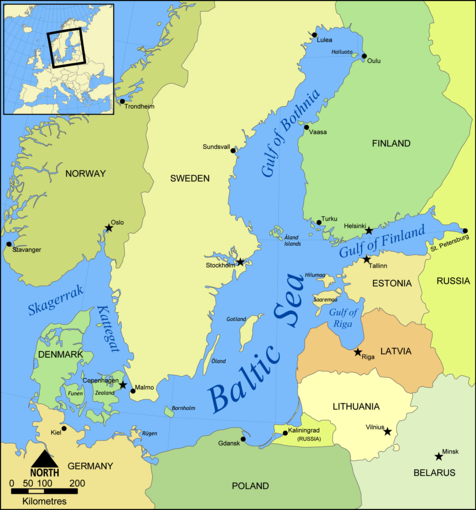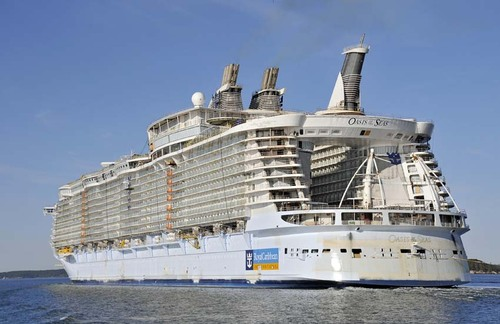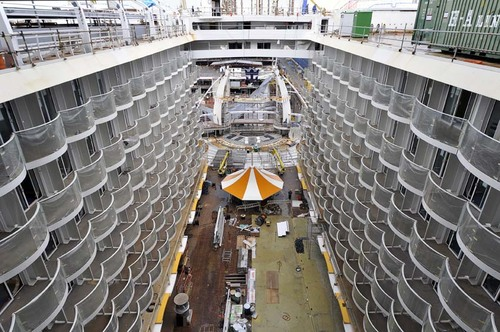New Mega Cruise Ships pose challenges for the Caribbean
Huge challenges lie ahead for the Caribbean in tourism, but none will be as big as coping with the two largest cruise ships in the world, one of which will be sailing the Caribbean starting this December.
The cruise ships will be of the Royal Caribbean International line. They are both presently under construction in Finland, a country little known in the Caribbean but whose products are major contributors to the economies of several Caribbean countries.
For example, 14 of the 14 largest cruise ships in the world – in other words all of them – have been built in Finland, a small northern Europe country bounded by Russia, Sweden, Norway and the Baltic Sea.
With a population of 5.3 million people and very little natural resources beyond forestry, Finland has become a modern European nation through its development and application of technological expertise. Building giant cruise ships with all the amenities and more of a main town centre in the Caribbean is just one of the examples of the achievements of this little country, once ruled by Sweden and then made an autonomous region of Russia before its independence in 1917.

Another example of its technological accomplishment is the remarkable global market that Finland has achieved in telecommunications with Nokia mobile telephones, mistakenly believed by many to be a Japanese product.
The cruise ships built in Finland are powered by engines manufactured by Wartsila, another Finnish company that has made an impact on the Caribbean. The engines in one of the large cruise ships provide more power than is required in a country such as St Lucia.
Of course, Wartsila is now the supplier to power companies of many Caribbean countries. It has developed the technological capacity to track by computers the performance of its engines wherever they are. Thus, from its headquarters in Finland, for instance, technicians can monitor impending problems and provide solutions. The company can do the same for the engines on board ships.
Wartsila will be doing this job for Oasis of the Seas which will be the largest cruise ship in the world when the builder, StxEurope, hands it over to Royal Caribbean International in October.
Many Caribbean ports will not see this ship or its sister, Allure of the Seas, even though Oasis starts sailing in December. They simply will not have the port facilities to accommodate them. Oasis will call at St Thomas (US Virgin Islands), St Maarten, and the Bahamas on its Eastern Caribbean cruise, and at Haiti and Jamaica on its Western Caribbean cruise up to April 2010.
Barbados and Eastern Caribbean countries, such as Antigua and Barbuda, St Kitts-Nevis, Dominica, Grenada and St Lucia will have to calculate whether or not it is worth the expense of trying to attract these two giant vessels to their ports.

Oasis of the Seas on a trial run in July 2009 before completion
I went to see the Oasis and the Allure under construction in Turku, a City on Finland’s Baltic Sea coast. Even in Europe with its modern high rise buildings, both ships dominated the landscape, dwarfing everything around it.
The Oasis was a hive of activity. The work on this 225,000 ton ship involved thousands of people and the organization of it would require the logistical expertise of a city municipality. It has taken 20 months to bring the ship from ground zero to the towering edifice it now is. It has to be delivered in 40 working days, and no one has any doubt that it will be.
But this is no ordinary ship. In truth, there is nothing else like it. It will carry 6,000 passengers and 2,160 crew, and unlike any other cruise ship, it will have a “Central Park”- a fully open air area in the centre of the ship giving inside Cabins both sunlight and a view. It is in fact a small town centre with restaurants, shops, bars, and three themed garden spaces.
One of the great engineering and technological accomplishments of the Finnish designers and engineers is a Bar that rises from the ground up to three levels levitated by jet-streams of water. But so too are basketball courts where Finnish research and development has overcome the problem of bouncing balls reverberating through the floor.
A huge open air Boardwalk with a real Carousel for kids, two rock climbing walls, a beach with real sand, ice cream parlor and shops, is at the other end of the ship. Another engineering and technological feat was stabilizing the Carousel so that it would not be affected by the movement of the sea.

Oasis of the Seas Boardwalk under construction in July 2009 (inside cabins can be seen)
StxEurope promote their work on the Oasis as “Creating the Incredible” - and they are right. The ship defies imagination. 1,181 feet long (361 m), 236 feet high (72 m) with 15 passenger decks and 2,700 cabins plus the amenities I have described here and even more besides, this ship has to be seen to be believed. The same is true of its sister, Allure.
The problems that the Caribbean Community and Common Market (CARICOM) countries face with these two huge ships are two in number.
First, apart from Jamaica, Haiti and the Bahamas which have port facilities to handle these ships, several of the others will have to build capacity to accommodate them; a cost-benefit analysis should be undertaken to advise a decision. The logistics of disembarking 6,000 passengers and getting them back on board in a six hour period will be trying indeed.
Second, these ships are destinations in themselves; they have more entertainment amenities including theatres, shopping, restaurants, bars, health spas, swimming pools, sports facilities than many Caribbean towns. They are also a safe and secure environment. In this sense, the ships themselves are direct competition for the Caribbean destinations at which they will call.
Why then should passengers come off these ships to visit Caribbean islands? That is the challenge that this new generation of cruise ships provide for tourism planners and policy makers in the region. Tourism officials have to devise new strategies and some major attraction to lure the larger number of passengers on these megaships. If not, Caribbean countries will become marginal to the cruise ship business, providing little more benefit than they now do.